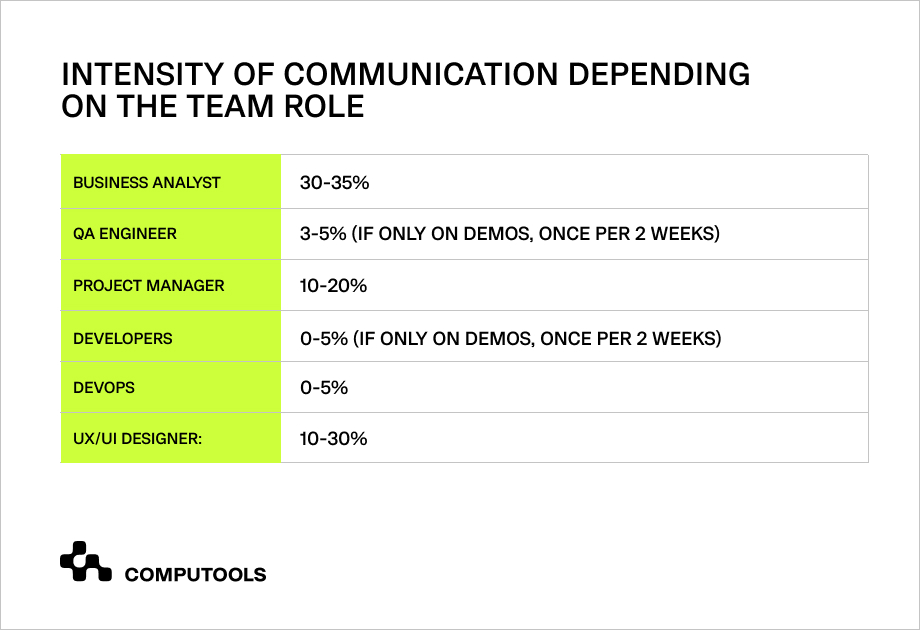Starting an IT project with a remote team can be seen as a venture. They work remotely, maybe located on the other side of the world, and the only bridge connecting both of you is most likely to be Slack, Skype or Telegram. By all means, each of these tools is reliable enough to give you instant access to any member from your team. But many clients are still wary to outsource the entire software development project to a bunch of professionals distributed across multiple time zones. These days there is not much difference between working with a local contractor or signing a deal with a remote one.
This article will guide you through Computools’s approach to handling each and every difficulty in building successful collaborations at a distance.
How to Smooth Out Time Zone Differences
Time zone differences indeed put some limitations on the time window which suits both the client and the team. Say, the more hours of time difference you have, the less chance it gives for real-time collaboration on an IT project. But does it always take full 8 hours of work in real time to keep the project well managed and delivered on time?
Our professionals from Computools say that this scenario is extremely rare and almost never happens. Why? First off, the majority of clients search for a team of software engineers that can self-manage their work: they know how to develop software systems from scratch and don’t expect extreme guidance or engagement in the process on the client’s side. As a result, out of all the development time, only 5 to 35% of the overall project hours account for client-team communication. Below are given more accurate estimates of communication intensity depending on the team role.

Obviously, it is crucial to find common time slots to suit both sides of the collaboration. But the main point is that it is easy to achieve no matter where our partner is headquartered as we do not expect our time zones to overlap for 8 hours. This orientation simplifies our accessibility to businesses that consider or plan to start software development projects with us.
Computools’s Communication Approach
The frequency and richness of communication is always dependent on the client’s willingness to get involved with the ins and outs of the project. Computools’s business approach is guided by the rule of common involvement: the company provides a solid communication pattern with necessary scheduled meetings and events that maintain the project consistency, but the client, in turn, has wide options to define their level of engagement in the development process:
• They can provide Product Owner on their side to articulate the product’s requirements to our Business Analyst and team;
• They can personally be present on our calls and communicate their must-have features and expectations of the product;
• They can rely on our pre-developed boxes (marketplace, videoconferencing, booking system, etc.) that offer partly ready-made solutions for SMEs in different industries that can use them to develop their own systems or CRMs.
Whatever the scenario, Computools is ready to create a comfortable working environment where both the client and the team are given the best conditions to continuously interact and improve the IT project being developed.
What Communication Models Do We Support?
There are five conventional communication models actively used in the business world to set up and maintain communication between the partner and the engineering team within the software development lifecycle. Every model described below is employed at Computools in so far as our clients need it. Let’s go through each of them and describe the cases when Computools sees it fit to use best.
1. Face-to-face conversations
Face-to-face meetings are not a regular form of communication during software development projects created at Computools, but they may take place upon necessity. Our company’s business development managers serve as a mediator between the client and the team, and they can arrange in-person meetings in our office to let clients get to know our professionals and see how we work day by day. Such meetings happen annually. Computools welcomes its partners from various regions and hosts them in all cities where the company is headquartered.
2. Video conversations
Video calls are the number-one and primary communication model chosen by Computools to initiate conversations with the client and lead IT projects. Video calls are most preferred within our company to stay connected to our clients, especially during the project development. Computools view video conversations as the best approach to ensure productive and smooth team-client interactions, and so, the company relies on a variety of communication tools that provide the necessary environment for leading video calls successfully. For instance, both requirements elicitation sessions during the discovery phase as well as product demonstrations during the development stage are both handled through video conferencing. On average, a video call may last from 30 minutes to 2 hours. This time frame is acceptable to enable collaborations with clients in remote time zones and overcome challenges resulting from time differences.
3. Phone conversations
Similar to face-to-face meetings, phone calls may be one-time events that take place when business development managers or project managers are faced with an urgency to get in touch with the client very quickly. Computools takes care of what’s going on from start to finish of the project development. So phone calls are possible and encouraged if our team needs some instant access to the client’s side. We rely on this communication method only if conventional messengers are not available and we run into critical issues that require fast clarification or solution. Overall, Computools’s approach see phone calls rather a secondary communication method to use during the development phase.
4. Videotape
Videotapes, or screencasts, are quite a popular practice for clients that opt not to be actively engaged in the project planning and further implementation. Screencasts can be a way of how Computools’s teams present their progress in work and software deliverables on demo meetings. It is equally the best option for clients located in time zones with 7+ hours of difference when finding a common time slot for real-time communication might be a challenge for both parties. There are a few main upsides to this communication model: the client is able to store all the videotapes and so can easily track the alignment of development with the predefined project plan and roadmap; unlike on video meetings, the client has also more time for providing a detailed and thorough feedback or remarks on the quality of work presented as well as suggesting potential changes if needed.
5. Email conversations
Emails have a wide usage in Computools’s business approach, but they fulfill rather a complementary function to the main communication model established on IT projects. Texting is most fit for follow-up letters, call agendas, summaries, meeting minutes, and other concise forms of information to be fixed and remembered while another more fundamental development process is taking place. To this end, Computools rely on emails mostly for doing paperwork, call and meeting arrangement, and other organizational aspects of project development.

How to Overcome Language Barriers Between the Client and the Team
International partnerships are inherently followed by a number of cultural differences and language barriers facing each of the parties. Computools’s team consists of professionals who are confident English speakers feeling comfortable while talking to their clients coming from different countries. Moreover, the company invests in staff training and education so that all engineers develop a strong knowledge of technical English. It is particularly important when it comes to working with API documentation, software specifications, library and technology documentation. Simply put, language barriers are not a hurdle for our specialists in building long-term relationships with their clients.
Computools’s philosophy is grounded on respect, tolerance and transparency. We are open to collaborate with any business regardless of their location. Language barriers may be a big issue for new companies that are only paving the way towards international partnerships. Computools is more than that. Since its foundation, the company has gained membership in Norwegian, British and Australian Chambers of Commerce, which proves its competence and expertise in providing quality services for software development and its ability to offer expertised engineers to work on custom software solutions.
Computools is a devoted IT provider that operates in multiple markets with R&D offices located in different regions across the globe. Should you have more inquiries into digital transformation technologies that drive SMEs towards a better future, please email at info@computools.com.

Computools
Software Solutions
Computools is a digital consulting and software development company that delivers innovative solutions to help businesses unlock tomorrow.









“Computools was selected through an RFP process. They were shortlisted and selected from between 5 other suppliers. Computools has worked thoroughly and timely to solve all security issues and launch as agreed. Their expertise is impressive.”